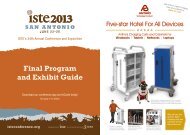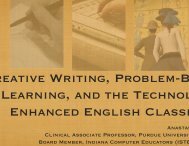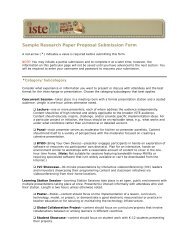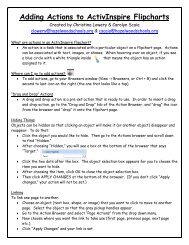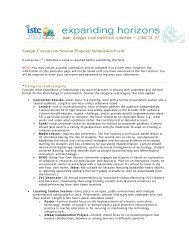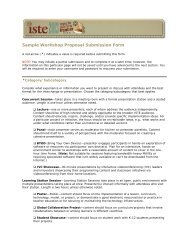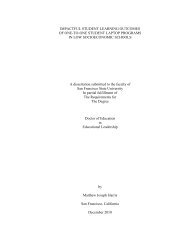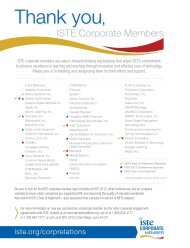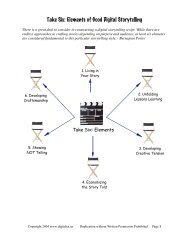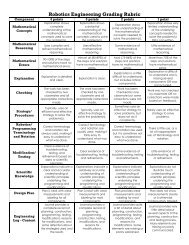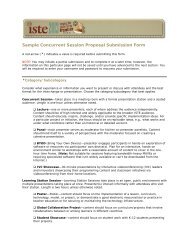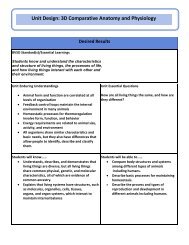Revised Bloom's Taxonomy The Cognitive Process Dimension
Revised Bloom's Taxonomy The Cognitive Process Dimension
Revised Bloom's Taxonomy The Cognitive Process Dimension
You also want an ePaper? Increase the reach of your titles
YUMPU automatically turns print PDFs into web optimized ePapers that Google loves.
<strong>Revised</strong> Bloom’s <strong>Taxonomy</strong><br />
<strong>The</strong> <strong>Cognitive</strong> <strong>Process</strong> <strong>Dimension</strong><br />
Name: Sample<br />
Authentic Topic: Oceans<br />
Grade Level: 6-8<br />
Directions:<br />
• Write at least one objective, activity, or assessment for each of the <strong>Cognitive</strong> <strong>Process</strong>es in the Bloom’s <strong>Taxonomy</strong> Levels.<br />
• Refer to the file, “<strong>Revised</strong> Bloom’s <strong>Taxonomy</strong> – Full Description”, for more information and assistance in developing activities<br />
for each level and process.<br />
<strong>Revised</strong> Bloom’s Levels<br />
<strong>Cognitive</strong><br />
<strong>Process</strong>es<br />
(Alternate<br />
Names)<br />
Definitions and<br />
Examples<br />
Objective, Activity, or Assessment<br />
1. Remember- Retrieve relevant knowledge from long-term memory<br />
1.1 Recognizing<br />
(Identifying)<br />
1.2 Recalling<br />
(Retrieving)<br />
Location knowledge in long-term memory<br />
that is consistent with presented material<br />
(e.g., Recognize the dates of important<br />
events in U.S. history)<br />
Retrieving relevant knowledge from longterm<br />
memory (e.g., Recall the dates of<br />
important events in U.S. history)<br />
• True or False: Mississippi is an ocean.<br />
• <strong>The</strong> United States touches which two oceans: Pacific Ocean, Atlantic<br />
Ocean, Indian Ocean, Arctic Ocean<br />
• List the major oceans and seas of the world.<br />
• Name two oceans that the United States touches.
2. Understand- Construct meaning from instructional messages, including oral, written, and graphic<br />
communication<br />
2.1 Interpreting<br />
(Clarifying,<br />
Paraphrasing,<br />
Representing,<br />
Translating)<br />
2.2 Exemplifying<br />
(Illustrating,<br />
Instantiating)<br />
Changing from one form of representation<br />
(e.g., numerical) to another (e.g., verbal)<br />
(e.g., Paraphrase important speeches and<br />
documents)<br />
Finding a specific example or illustration of<br />
a concept or principle (e.g., Give examples<br />
of various artistic painting styles)<br />
Paraphrase the short story about Pablo’s trip on the ocean.<br />
Which of the following pictures illustrates corrosion of the ocean floor?<br />
2.3 Classifying<br />
(Categorizing,<br />
Subsuming)<br />
2.4 Summarizing<br />
(Abstracting,<br />
Generalizing)<br />
2.5 Inferring<br />
(Concluding,<br />
Extrapolation,<br />
Interpolating,<br />
Predicting)<br />
2.6 Comparing<br />
(Contrasting,<br />
Mapping,<br />
Matching)<br />
2.7 Explaining<br />
(Construction)<br />
Determining that something belongs to a<br />
category (e.g., Classify observed or<br />
described cases of mental disorders)<br />
Abstracting a general theme or major<br />
point(s) (e.g., Write a short summary of<br />
events portrayed on a videotape)<br />
Drawing a logical conclusion from<br />
presented information; occurs in a context<br />
that supplies an expectation of what is to be<br />
inferred (e.g., In learning a foreign<br />
language, infer grammatical principles<br />
from examples)<br />
Detecting correspondences between two<br />
ideas, objects, and the like (e.g., Compare<br />
historical events to contemporary<br />
situations)<br />
Construction a cause-and-effect model of a<br />
system (e.g., Explain the causes of<br />
Review the pictures of animals. Group them into three categories: land animals,<br />
deep ocean animals, shallow ocean animals.<br />
Click on the link about Seals and Walruses. Summarize the paragraph titled,<br />
“What are pinnipeds?”<br />
Describe the principle of hot water and cold water movement in the ocean. How<br />
does it affect the ocean and land?<br />
• Compare each of the following ocean-related terms and tell how they are<br />
related: continental slope, currents, tides, ocean floor, coast, waves, swells<br />
and salinity. Use http://creately.com/Draw-Venn-Diagrams-Online to create<br />
Venn Diagrams online.<br />
• Compare/contrast an ocean with a lake, a sea and a river. Use a Venn<br />
Diagram to help you record the similarities and differences.<br />
• Explain the causes of a tsunami.<br />
• Explain how waves are formed.
important 18 th -century events in France)<br />
3. Apply- Carry out or use a procedure in a given situation<br />
3.1 Executing<br />
(Carrying out)<br />
3.2 Implementing<br />
(Using)<br />
Apply a procedure to a familiar task (e.g.,<br />
Divide one whole number by another<br />
whole number, both with multiple digits<br />
Applying a procedure to an unfamiliar<br />
task (e.g., Use Newton’s Second Law in<br />
situations in which it is appropriate)<br />
Use goldfish crackers as manipulatives for the children to make up word<br />
problems; e.g., 3 goldfish were swimming and they saw 2 beautiful goldfish<br />
swimming nearby. <strong>The</strong> 3 goldfish asked the 2 goldfish to swim with them. Now<br />
how many goldfish are swimming together? Have the children record their<br />
equations.<br />
• After studying about how submarines travel, the students will simulate the rise<br />
and fall of a submarine using eyedropper, tall glass, water, 2-liter plastic bottle<br />
with top, and scissors. Let students apply the submarine travel procedures<br />
with the supplies. (Answer: Fill the eyedropper and the glass with water. Slowly<br />
squeeze the bulb of the eyedropper until the dropper just barely floats vertically; the top<br />
half-inch of the bulb should bob above the surface. Remove the label from the 2-liter bottle<br />
and fill it with water. Without squeezing the bulb, carefully transfer the eyedropper from<br />
the glass to the bottle, pointed end down. Add water to the bottle until it overflows. <strong>The</strong>n<br />
tightly screw on the cap. Gently squeeze the bottle. <strong>The</strong> dropper should dive like a sub<br />
when you squeeze and rise to the surface when you release the sides of the bottle.)<br />
• Is it easier to swim or float in salt water than in fresh water? Give the<br />
students two large glasses, salt, water, two eggs. Instruct students to use<br />
the scientific method to experiment and discover in which water the egg<br />
will float and how much salt it takes. Have students write each step of the<br />
scientific method during their experiment to answer the question.<br />
4. Analyze- Break material into its constituent parts and determine how the parts relate to one another and to<br />
an overall structure or purpose<br />
4.1 Differentiation Distinguishing relevant from irrelevant After an experiment demonstrating that ocean currents are caused by the rising
(Discriminating,<br />
Distinguishing,<br />
Focusing,<br />
Selecting)<br />
parts or important parts of presented<br />
material (e.g., Distinguish between<br />
relevant and irrelevant numbers in a<br />
mathematical word problem)<br />
and sinking of warmer and colder water. Distinguish the most important<br />
concepts that cause the formation of ocean waves and list the concepts and<br />
illustrations/pictures in a Prezi presentation.<br />
4.2 Organizing<br />
(Finding<br />
coherence,<br />
Integrating,<br />
Outlining, Parsing,<br />
Structuring)<br />
4.3 Attributing<br />
(Deconstructing)<br />
Determine how elements fit or function<br />
within a structure (e.g., Structure evidence<br />
in a historical description into evidence for<br />
and against a particular historical<br />
explanation)<br />
Determine a point of view, a bias, values,<br />
or intent underlying presented material<br />
(e.g., Determine the point of view of the<br />
author of an essay in terms of his or her<br />
political perspective)<br />
True or False: All the water on land eventually reaches the ocean. Explain your<br />
response.<br />
Create a blog that outlines the evidence that your geographic area does or does<br />
not contribute to the environmental quality of the ocean.<br />
How can we save the endangered species,<br />
the Blue Whale? Create a digital story<br />
from the Blue Whale’s point of view<br />
describing how he feels about why he is<br />
endangered, how he can be saved, and<br />
what a day is like in his life. Use<br />
appropriate pictures and music, original<br />
narration, and title captions.<br />
5. Evaluate- Make judgments based on criteria and standards<br />
5.1 Checking<br />
(Coordinating,<br />
Detecting,<br />
Monitoring,<br />
Testing)<br />
5.2 Critiquing<br />
(Judging)<br />
Detecting inconsistencies or fallacies<br />
within a process or product; determining<br />
whether a process or product has external<br />
consistency; determining the effectiveness<br />
of a procedure as it is being implemented<br />
(e.g., Determine if a scientist’s conclusions<br />
follow from the raw data)<br />
Determining inconsistencies between a<br />
product and external criteria; determining<br />
Use a spreadsheet to present the inconsistencies of costs in three methods of<br />
marine animal conservation efforts.<br />
<strong>The</strong>re is great controversy surrounding the endangered species list related to<br />
when a species should be considered endangered, when should the species be
whether a product has external<br />
consistency; procedure for a given problem<br />
(e.g., Judge which of two methods is the<br />
best way to solve a given problem)<br />
removed from the list, whether governments can take land to protect habitats<br />
from development, and loopholes to the protection laws. Placing a species on the<br />
endangered list often causes the value to soar for poachers and collectors and<br />
makes the poaching worse. Create a wiki that points out the inconsistencies in<br />
the reasons for poaching and the reasons to save endangered animals.<br />
6. Create- Put elements together to form a coherent or functional whole; reorganize elements into a new<br />
pattern or structure<br />
6.1 Generating<br />
(Hypothesizing)<br />
6.2 Planning<br />
(Designing)<br />
6.3 Producing<br />
(Constructing)<br />
Coming up with alternative hypotheses<br />
based on criteria (e.g., Generate<br />
hypotheses to account for an observed<br />
phenomenon)<br />
Devising a procedure for accomplishing<br />
some task (e.g., Plan a research study<br />
about the effects of rain on erosion in the<br />
school yard)<br />
Inventing a product (e.g., Build habitats<br />
for a specific purpose)<br />
• Debate whether more money should be spent to explore the ocean floor.<br />
Create a video to pose two or more original alternative reasons for or against<br />
exploring the deep ocean floor.<br />
• <strong>The</strong> United Nations has established the Law of the Sea. Hypothesize how this<br />
policy supports the idea that the ocean remains sustainable for the society,<br />
culture, and environment of a particular area.<br />
• Some proponents of the UN Law of the Sea believe that the treaty will<br />
establish a system of property rights for mineral extraction in deep sea<br />
beds, making the investment in such ventures more attractive.<br />
Hypothesize how this type of drilling and mineral extraction will affect<br />
the economy, energy sources, and the animal life in the immediate<br />
location.<br />
• Design an original procedure to explore the ocean more than 3 miles deep.<br />
• Plan a deep sea research study to test mineral extraction in three different<br />
locations in the world. Create a proposal to a large mineral organization using<br />
spreadsheets to determine costs, equipment/staff needed, etc. Use desktop<br />
publishing software to create a brochure about your proposal.<br />
• Invent a deep water exploration vehicle that includes all research equipment,<br />
living quarters, etc. needed to sustain the researchers for at least a month. Use<br />
CAD software to create the architectural plans.<br />
• Invent an original drill that will extract minerals from the ocean floor that is<br />
more than 3 miles deep that will not disturb plant life and minimal damage to
the ocean floor. Use CAD software to create the equipment plans.<br />
Reference:<br />
Anderson, L. W., Krathwohl, D. R., et al (Eds..) (2001). A taxonomy for learning, teaching, and assessing: A revision of bloom's taxonomy of educational objectives.<br />
Boston, MA: Allyn & Bacon.<br />
Sample compiled by Dr. Marge Maxwell



